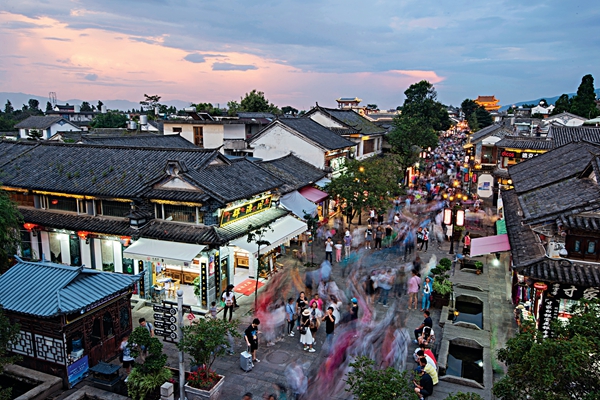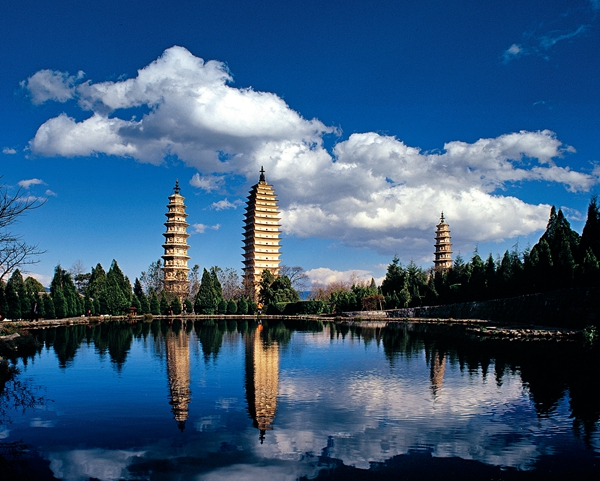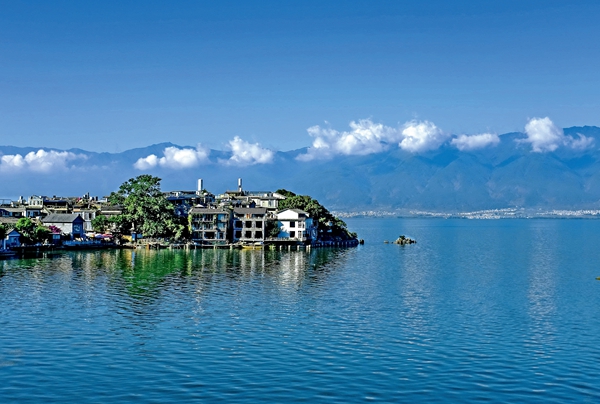Dali: a charming folk city
 0 Comment(s)
0 Comment(s) Print
Print E-mail China Toady, January 8, 2018
E-mail China Toady, January 8, 2018
The Dali Old Town sits in Dali City, the seat of Dali Bai Autonomous Prefecture in Yunnan Province. The town first emerged as the capital of the Nanzhao Kingdom (738-937), and later served as the capital of the Kingdom of Dali (937-1095, 1096-1253). It used to be a political, economic, and cultural center of Yunnan for as long as 500-odd years.

Dali City is home to many ethnic minorities, with the number of Bai people accounting for over half of its population. Bai is the 15th largest ethnic minority group in China, and most of its people live in concentrated communities. The Bais have distinctive customs, and are good at architecture, wood carving, and painting.
Dali is renowned for its four sceneries in different areas. Its beautiful cloud scenery in Xiaguan Town under the influence of ceaseless wind due to the local geography, a flower-covered meadow in Shangguan Town, gleaming white snow on the Cangshan Mountain, and peaceful moonlight over the Erhai Lake.
Kingdom in Martial Arts Fictions
Many people first know about the Kingdom of Dali through a martial arts fiction by Jin Yong (Louis Cha), a famous Chinese martial arts novelist. The leading man in Jin's representative work Demi-Gods and Semi-Devils is a prince of Dali Kingdom, Duan Yu, who succeeded to the throne. In history, there was a king of Dali Kingdom, whose name is Duan Heyu.

The history of the Dali Kingdom dates back to 937, when the Duan family first established the kingdom. They adopted today's Dali Old Town as its capital just as the previous Nanzhao Kingdom did. The Dali Kingdom had 22 kings in its 316 years of history. In 1253, Kublai Khan (1215-1294) led the Mongolian army to wipe out the Dali Kingdom. This marked a turning point for Dali as it signified the end of the era when Dali served as a political, economic, and cultural center of Yunnan. Since then, Kunming, today's capital of the province, has become the political center of Yunnan.
What stands out most in Jin Yong's novel about Dali is the Tianlong (Heavenly Dragon) Temple and vast areas of camellia flowers.
The Tianlong Temple in the novel is a royal temple of the Dali Kingdom. Many abdicated kings became monks and practiced martial arts here. The book stated that the temple is located north of the Cangshan Mountain. Its official name is Chongsheng, but local residents are now used to calling it Tianlong Temple.
Since Yunnan Province is geographically close to Southeast Asian countries, Buddhism was prevalent in the Dali Kingdom. Many time-honored Buddhist temples, pagodas, and sculptures are still found in the region today. The Chongsheng Temple was a center for Buddhist activities during the kingdom's era. Among the total 22 kings of Dali, nine became monks after their abdication. A king of Myanmar visited Chongsheng Temple twice. However, in the mid-19th century, the temple was destroyed in a big fire, and only three pagodas survived, which have come to be known as the Three Pagodas of Chongsheng Temple.
In Jin Yong's novel, Duan Yu spoke highly of camellia flowers in Dali, which has aroused the readers' interest to see them with their own eyes.
The camellia, popularized by a French book, in fact originated in China, and Dali is one of its hometowns. The camellia flowers in Dali are big in shape and bright in color. As early as 1,500 years ago, local people started cultivating this plant. The royal court of the Dali Kingdom considered the camellia as the "emperor's flower." In the seventh century, camellia spread to other areas of Asia through Japan and other neighboring countries. In the 18th century, it spread to Europe and America. Today, people in Dali still have the tradition of growing camellias. When spring comes, the camellia flowers on mountains and family yards blossom, making Dali a brightly-colored world of flowers.
Distinctive Bai Customs
The Bai people believe in Benzhunism, the indigenous religion that worships local patron gods, rendered as Benzhu in Chinese.
The Bai people like the color white, and consider it a symbol of honor. The dominant tone of their costumes is white. Bai men mostly wear white shirts and black vests with embroidered decorations along the vest's perimeter. They wear loose white or blue pants, and sport headwear that looks like a turban. In some regions, men carry a pouch with beautiful embroideries, which are given by their girlfriends as a symbol of love.

The Bai women in Dali often wear white shirts and red vests, with an embroidered belt that holds the half apron along the waist in place. They also wear loose blue pants and lavishly embroidered shoes.
The hairstyle of a Bai woman tells her marital status. If she is unmarried, she often wears a pigtail, and wraps it outside her globular headwear, with a white tassel hanging on its left side. After she is married, she makes a bun, and bundles it on the top of head, with indigo-blue cloth wrapped outside.
In fact, the headwear of a Bai girl also reflects the four natural sceneries of Dali which were previously mentioned. The tassel which swings in the wind reflects the "wind" in Xiaguan Town; the brightly-colored embroidered headwear refers to flowers in the meadow of Shangguan Town; the pure white top of the headwear resembles snow on the Cangshan Mountain, and the curving shape of the headwear looks just like the crescent moon above the Erhai Lake.
The Bai People often welcome guests with local liquors or teas. They have a tradition of filling the cup when offering liquor, but fill only half of a cup when offering tea. It would be great if you could say "thanks" in the local language, which sounds like "nuo wei ni," when you are received by a Bai family.
Cangshan Mountain and Erhai Lake
Besides rich culture and long history, the breathtaking natural scenery in Dali has drawn countless tourists from home and abroad. The Cangshan Mountain and Erhai Lake are a must see.
The Cangshan Mountain is composed of 19 peaks which run from north to south. There is a creek flowing down between every two peaks and emptying into the Erhai Lake on the east side of the mountain. It is the second largest freshwater lake in Yunnan Province. Between the Cangshan Mountain and the Erhai Lake lies a fan-shaped alluvial plain, formed due to the impact of running water of the creeks; this is where the Old Town of Dali is located.
The Cangshan Mountain lies at a low latitude on a high plateau. On its top there are moraine lakes that are surrounded by primitive forests. Different plants grow at different elevations, forming layers of different scenery that change with the four seasons. Various flowers, including camellia, magnolia, lily, and azalea, are found across the mountain. There are 41 species of azaleas growing from the mountain base to the snow belt area at an elevation of 4,000 meters, forming a "sea of flowers." Due to the high elevation, the Cangshan Mountain is snow-capped throughout the year. Looking from afar, its top gleams under the sunshine; therefore the "snow on the Cangshan Mountain" has been a signature scenery of Dali City.
Currently there are three cableways on the mountain, among which is a 5.5-kilometer-long one to the Horse Washing Pond on the mountain top. The pond is a moraine lake with a depth of 1.7 meters. It is said that Kublai Khan once stationed here when his troops arrived in Dali and had his horse washed in the pond, which is where the pond derives its name. Around the lake are azaleas, and the water in the pond is crystal clear.
The Erhai Lake is an alpine sag pond, with transparent water and various aquatic lives. According to folklore, the Bai people living near the lake would row a boat to appreciate the reflection of the golden moon at night of every Mid-Autumn Festival. The moonlight, clouds, and vast lake surface form a charming picture; therefore the "moonlight on the Erhai Lake" has also been a signature scenery of Dali.
A 115-kilometer-long road has been built for tourists to drive a car or ride a bicycle around the lake. There are many Bai residential houses along the road. Every household grows the purple-red great bougainvillea, which looks lovely against the traditional Bai houses of white walls and dark grey tiles. This is a good way for tourists to experience local life by staying in a guesthouse for a few days to enjoy tea, and watch the sunrise and sunset on the Erhai Lake.






Go to Forum >>0 Comment(s)